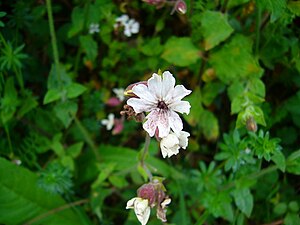Microbotryaceae
| Microbotryaceae | ||||||||||||
|---|---|---|---|---|---|---|---|---|---|---|---|---|

|
||||||||||||
| Systematics | ||||||||||||
|
||||||||||||
| Scientific name | ||||||||||||
| Microbotryaceae | ||||||||||||
| RT Moore |
The Microbotryaceae form a family from the order of the Microbotryales. The so-called anther brandies on carnation plants belong to this family .
features
Macroscopic features
The Microbotryaceae parasitize on a wide variety of plant species. They are macroscopically recognizable by the transformation of the stamens , stamens or ovaries of their hosts into mostly dark-colored spore beds ( Sori ), which make the flower appear dirty, powdered. The Sori also rarely develop on whole flowers or in leaf tissue.
Microscopic features
The Microbotryaceae have longitudinally septate basidia . Their hyphae grow intercellularly in the host, but have no suction threads. The teliospores are spherical, egg-shaped or angular, hyaline to brown or pale purple and smooth to warty. The teliospores germinate and form a three- to four-cell promycelium (basidium) from which sedentary basidiospores are formed, which are narrow, hyaline and unseptated. In contrast to its sister family Ustilentylomataceae , their hyphae only have pore-free septa even when they are mature .
Ecology and diffusion
The Microbotryaceae occur worldwide in temperate zones. Even if the best-known species parasitize on the carnation family , they occur particularly on the knotweed family and on a total of nine plant families. Other species are parasitic on representatives of the daisy family , teasel family , Gentian family , mint , lentibulariaceae and evening primrose plants . Because they are found on the anthers, they are considered a sexually transmitted disease .
Taxonomy
The Microbotryaceae have long been associated with the smut fungi because their life cycle is similar. However, they are more closely related to rust fungi .
- Bauerago : on sour grasses and rushes
- Bauhinus
- Haradaea
- Liroa
- Microbotryum : largest genus
- Sphacelotheca
- Zundeliomyces : monotypical with only one species: Zundeliomyces polygoni
swell
literature
- Paul F. Cannon, Paul M. Kirk: Fungal families of the world . CABI Europe, Wallingford, Oxfordshire (UK) 2007, ISBN 978-0-85199-827-5 , pp. 214 ff . ( limited preview in Google Book search).
Individual evidence
- ↑ a b Martin Kemler, Markus Göker, Franz Oberwinkler, Dominik Begerow: Implications of molecular characters for the phylogeny of the Microbotryaceae (Basidiomycota: Urediniomycetes) . In: BMC Evolutionary Biology . tape 6 , 2006, p. 35 , doi : 10.1186 / 1471-2148-6-35 ( biomedcentral.com [PDF; 557 kB ]).
- ↑ Kaltz, O. and Shykoff, JA (2001), Male and female Silene latifolia plants differ in per-contact risk of infection by a sexually transmitted disease. Journal of Ecology, 89: 99-109. doi: 10.1046 / j.1365-2745.2001.00527.x